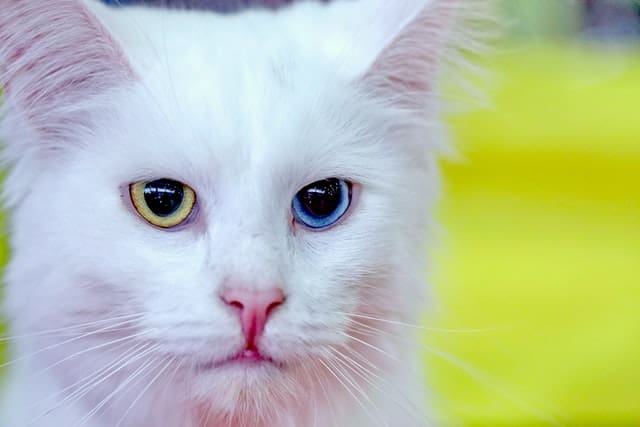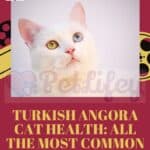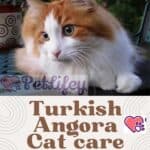Intelligent and playful, he is a cat who loves company

The Turkish Angora cat is a strong and frugal feline. It loves children and is easy to train. Its origins are lost in the mists of time and are accompanied by many legends.
Why is it called Angora Cat
That of the Turkish angora cat is a true breed, which is identified by a docile character and important skills in the agility-cat. As the name itself says, translated from the city of Ankara, it is originally from Turkey, where the first evidence of its presence dates back to the 15th century.
A century later, the Turkish angora cat arrives in the Old Continent, as a tribute by the Turkish sultans to the royal families and noble figures of the time.
In 1930, the Turkish government made it a national monument, declaring the Turkish white-haired angora cat a sacred animal.
In fact, a popular belief has it that he is the reincarnation of the great statesman Ataturk, whose most salient physical trait was probably that of having very clear eyes, a characteristic not widespread among the population. Thirty years later the standard is recognized and even more colors are present.
Turkish Angora Cat : Appearance
The Turkish Angora cat is a medium-sized animal, with a medium-small, triangular head, pointed ears and semi-long hair. The male specimens must not exceed 5 kg of weight, while the females touch a maximum of 4 kg.
The front legs are slightly shorter than the hind legs, the feet are small and round. The Turkish Angora cat is characterized by an elegant bearing despite having a muscular build.
The neck is long and thin and the eyes are large and almond shaped. The undercoat is not soft but not woolly while the coat is soft and silky.
In addition to the classic white with uneven eyes that has defined the standard, the coat of this cat breed can take on different colors, chocolate and lilac variants, which however are not yet accepted for display purposes. Different color of the eyes: all variants are welcome as long as they are intense.
Turkish Angora Cat: Character
Joyful, agile, affectionate: these are the main characteristics of this cat. Turkish Angora Cat willingly devotes itself to its owners with cuddles and games.
It loves children. It also loves adventure. Being a lively, agile and very intelligent feline, it is easily trainable.
To preserve the correct psycho-physical balance, the kennel must be placed in a place in the house that is not too isolated. The Turkish angora cat is not affected by the hours spent alone in the house but prefers the company, even of other animals .
Turkish Angora Cat : care
This cat needs some special attention, especially as regards feeding. In fact, it tends to put on weight, which is why, once a day, it is good to integrate the crunchies with wet food based on fish or meat.
Despite being semi-long, the hair does not form knots. To preserve its neat and shiny appearance, it is recommended to brush it at least once a week, 2 during the moulting period.
Turkish Angora Cat : diseases
Unfortunately, however, the Turkish angora cat is subject to several serious diseases . The most common is hypertrophic cardiomyopathy (HCM), a heart problem that can lead to death, but which can be diagnosed by annual echocardiography. The other is genetic ataxia, which develops in puppies by the 3rd month of life. Linked to the white color, on the other hand, there are hereditary deafness, for which there are reliable tests and treatment protocols , and the eosinophilic granuloma complex, a dermatological disease.
Turkish Angora Cat : Prices
Both at certified farms and online, its price varies from USD $120 to $400.






